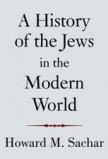Hard Times
On khokmes, as they say in Yiddish (but seriously), nobody, not even a veteran scholar like Professor Sachar, could compress the whole of modern Jewish history into a mere 800-plus pages with (alas) no maps, photographs or statistical tables. Not if you start, roughly, with the horrific massacres led by the Ukrainian hetman Bohdan Chmielnicki in the mid-17th century and then trace the political, economic, social and cultural fortunes of the Jews on six continents for the next 350 years. Something has to give.
Sachar is the son of Abram Sachar, the first president of Brandeis University, a historian and public television personality back in the 1950’s. Now 77 and retired from George Washington University, Howard Sachar has written 15 substantial books on Jewish history and edited the 39-volume Rise of Israel: Documentary History. You might say he knows the territory. If he does not, in fact, cover the immense span from, say, Moses Mendelssohn to Robert Moses, or from Spinoza to Seinfeld, it’s not that he couldn’tbut he would need a lot more space.
The broad outline of his story should be familiar to many readers. Beginning with the Enlightenment, Western European countries slowly lowered some of their age-old barriers to Jewish participation in civic life. Jews streamed out of the ghetto, founded an Enlightenment movement of their own (Haskalah) and eventually reaped what may have been the richest intellectual, cultural and artistic harvest, proportionate to their numbers, of any ethnic group in any period. Then came the Holocaust, which annihilated more than a third of the world’s Jews; the State of Israel (1948); the wars with the Arabs; the exodus from Russia; the age of terrorism and more. It would have been nice if this tumultuous-catastrophic series of events had ended with Israel’s becoming a normal, boring country like Belgium, far from the spotlight; but that, of course, was not in the cards.
What Sachar does, then, is review the vicissitudes of the modern Jewish quest for freedom and self-expression, often in the face of fierce opposition from conservative Christians in places like the France of the Dreyfus Affair, the Rome of Pio Nono, the Vienna of Karl Lueger and the Russia of Nicholas II. As for the Holocaust, the success of Daniel Jonah Goldhagen’s Hitler’s Willing Executioners (1996) may have obscured the massive role played by non-Germans in both the ferocious racial anti-Semitism that spread over Europe in the wake of the Great Depression and the day-to-day functioning of the Einsatzgruppen and the death-camps. If so, Sachar provides painfully detailed reminders of the relentless Jew-hatred in Poland, Lithuania, Ukraine, Hungary, Rumania, France and elsewhere. It is comforting to read about the wartime rescue of Jews in Denmark, Italy and Bulgaria; but those were the exceptions. And while the United States never actively persecuted the Jews (as distinguished from discriminating against, despising and excluding them), the rampant nativism and anti-Semitism of the 1930’s (thank you, Father Coughlin et al.) and 1940’s slammed the immigration door more or less shut and contributed to the deaths of many thousands of Jews. (Sachar politely avoids raising the issue of whether F.D.R. should have bombed Auschwitz.)
Sachar’s treatment of the history of Israel itself is, as one might expect, thorough and careful. While he cannot help celebrating the heroic achievement of generations of Zionists, he does not whitewash the Haganah’s campaign of anti-British sabotage and murder to force the Mandate administration to decamp. And he ends with a rueful survey of the rise of the new, politically correct, pro-Palestinian anti-Semitism. If the Jews throughout their long Diaspora experience had functioned as hostages of gentile political and diplomatic behavior, Sachar wonders, were they to function now as hostages of Israeli political and diplomatic behavior? Was that to be their fate even in bountiful and pluralistic America? The prognosis was uncertain. As always, Jewish anonymity is a contradiction in terms.
Meanwhile, in addition to all his other Samsonian tasks, Sachar tries to sum up the staggering Jewish achievements in the arts and sciences; inevitably he falls short here. He has to rush through an epic cast of characters; and there are omissions, dubious emphases and some plain mistakes. He largely ignores Jewish writers in English; he wrongly dismisses Nietzsche as a German imperialist-chauvinist; he awards Stefan Zweig a degree in law (it was in philosophy) and makes the gentile Adolf Loos into a Jew. At times he seems to become simply fatigued, and his language turns awkward and repetitious. (In any event, readers seeking more information on Jews in the United States can always look into Sachar’s more leisurely 1,000-page History of the Jews in America [1992].)
Writing in The New York Times recently, Steven J. Zipperstein faulted Sachar’s book for not dealing with the rhythm of daily life, what it felt like for the vast majority to experience their Jewish lives. True enough, but daily life in a 19th-century Galician shtetl differed spectacularly from life in Buenos Aires or Manhattan or Moscow or Melbourne a century later; and in 2005, where are we to find that vast majority? Is the typical Jew a Lubavitcher or a secular maskil like Sachar? Is he or she Orthodox, Conservative, Reformed, Reconstructionist or a godless Apikoros? More Woody Allen or Joe Lieberman? Sachar does not even address such questions, but he does supply the data for understanding where these seemingly contradictory phenomena came from. The rest is up to us.
Sofkl-sof (after all), he just finished writing a clear, solid, fair-minded and very long book on a supremely vexing subject. The man deserves praise and rest.
This article also appeared in print, under the headline “Hard Times,” in the November 21, 2005, issue.








